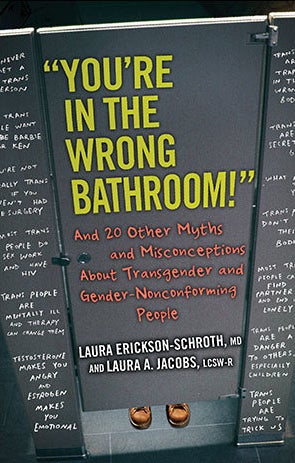
Despite burgeoning media coverage of transgender people, myths and misinformation persist about trans lives, relationships, and health. Here are 6 common myths about transgender and gender nonconforming people.
1. You’ve Never Met a Transgender Person
Although there are an estimated 1 million transgender people in the United States (one in every 333 people), most outsiders don’t think they’ve ever met anyone trans. One of the reasons for this is that until recently the only estimates we had were based on how many people showed up at clinics asking for surgeries. Today we know that many transgender people don’t have surgeries, either because they don’t want them or can’t afford them. Instead of doctors in clinics making estimates, researchers have begun conducting population-based studies asking people about how they identify, documenting that far more people than previously thought identify as trans and have complex identities which might not be visible. What’s more, while cisgender people often think they can recognize someone trans on sight, many in this community “pass” and may go unnoticed.
2. All Trans People Want to Be Either Barbie or Ken
Many of the transgender celebrities we’ve witnessed coming out in the last few years have binary identities, meaning that how they understand themselves and how they present (clothing, mannerisms, and lifestyle) generally fall within male or female stereotypes. Historically, physicians acted as “gatekeepers” to hormones or surgery, approving medical treatments only for those who were able to demonstrate that they fit cultural stereotypes for men and women.
But through activism there are many clinics that provide treatment based on a model called Informed Consent, where clients are given the information they need to make decisions for themselves, and now trans people are far more diverse, with every kind of identity imaginable. Genderqueer people, for example, may identify as being between genders, feeling both masculine and feminine, or neither masculine nor feminine, or as having genders that are political expressions challenging gender norms. Even those who transition from one traditional gender to another may feel they do not want to “play a role” by being overly masculine or feminine, but instead are comfortable defying standards. The trans and gender nonconforming community is a rich tapestry of people exploring genders in countless ways not possible before.
3. Trans People Are “Trapped in the Wrong Body”
We’ve all heard the phrase. But are trans people really “trapped in the wrong body?” We don’t know much about how gender identity develops, and, at this point, medical studies have been inconclusive. There is some evidence that prenatal hormones – those hormones we are exposed to in utero before we are born – may contribute to gender identity, but the mechanism is still unclear. In lieu of specific evidence, some feel “trapped in the wrong body” accurately describes their experiences while others understand their identities as more complicated, and as potentially involving choice rather than being predetermined by biology.
4. Trans People are Mentally Ill and Therapy Can Change Them
Historically trans people have been seen as mentally ill simply for being trans, and even the most recent edition of the Diagnostic and Statistical Manual of Mental Disorders (DSM-5), released in 2013, includes the diagnosis Gender Dysphoria. While some see this as an improvement from the previous edition’s more stigmatizing Gender Identity Disorder, others feel diagnoses for “trans-ness” should be removed altogether. Even today the belief persists that gender identity can be altered through “reparative” or “conversion” therapy. However, there is significant evidence that these treatments are unsuccessful, and can be harmful or even traumatic.
Although being transgender is not a mental illness, trans populations do have higher than average rates of depression, suicidality, and substance abuse, though researchers have shown that this is largely due to social stigma and not being trans in itself. Trans youth in supportive environments show no higher rates of mental illness than their cisgender peers.
5. Laws Support Trans People
Although social acceptance of transgender people is increasing, laws are not keeping pace. Currently no federal law protects trans people from discrimination, so state-by-state and even city-by-city, trans people continue to fight for their rights. Some locations have laws that protect against discrimination in housing and employment, but in many places trans people have no recourse if there are fired or evicted simply for being trans. A number of legal organizations provide information on trans rights across the United States, and make it clear that there is still much work to be done.
6. Trans People are in the Wrong Bathroom
Long before the 2016 North Carolina “bathroom bill” requiring people to use bathrooms corresponding with the sex on their birth certificates, there was already significant controversy over transgender people and bathrooms. Arguments typically revolve around transgender women being a danger to cisgender women and children.
However, the evidence clearly contradicts this notion. The opposite is actually true: there are no documented cases of trans people assaulting anyone in a bathroom. Ever. In fact, trans people are far more likely to be victims of violence than perpetrators, and many groups keep statistics on the number of trans people murdered each year because it is so common.
Most trans people simply want to pee in peace.
Laura Erickson-Schroth, MD, MA (New York, NY), is a psychiatrist working with LGBTQ people in New York City. She is the editor of Trans Bodies, Trans Selves, a resource guide written by and for transgender people. Her new book with Laura A. Jacobs is “You’re in the Wrong Bathroom!” And 20 Other Myths and Misconceptions About Transgender and Gender Non-Conforming People.
Laura A. Jacobs, LCSW-R (New York, NY) is a trans and genderqueer-identified psychotherapist, writer, activist, and public speaker working with transgender and gender-nonconforming, LGBTQ+, and sexual/gender diversity issues, and Chair of the Callen-Lorde Health Center in Manhattan. Her new book with Laura Erickson-Schroth is “You’re in the Wrong Bathroom!” And 20 Other Myths and Misconceptions About Transgender and Gender Non-Conforming People.
